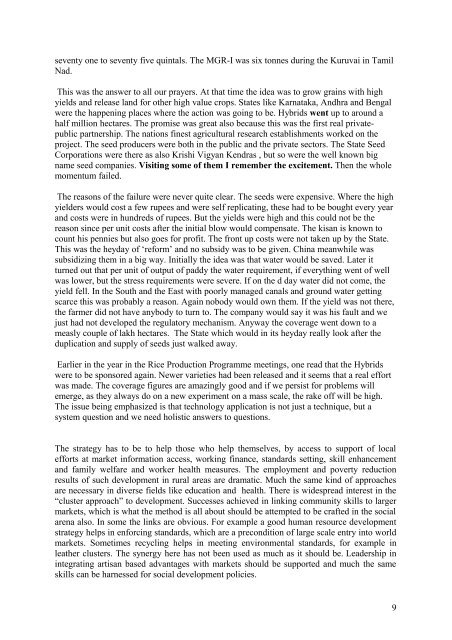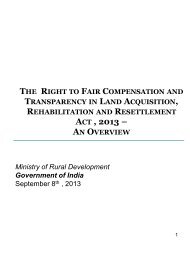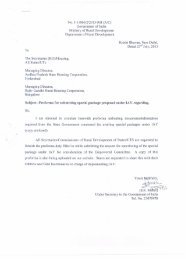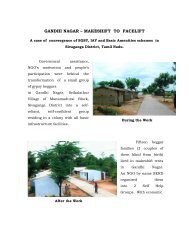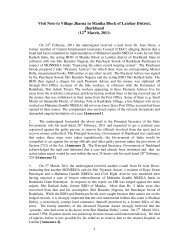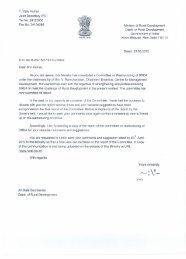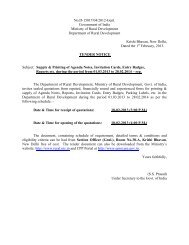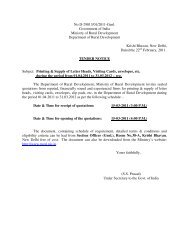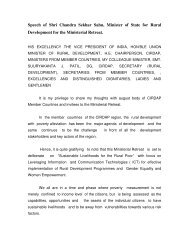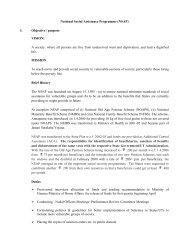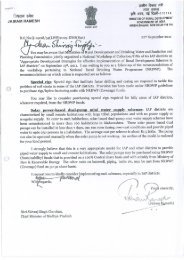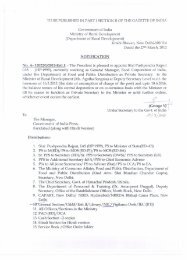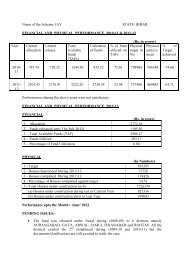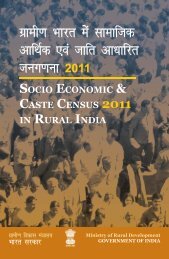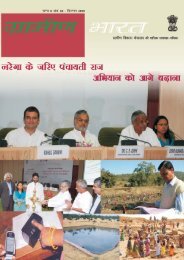UGC Report on Inter University Center on Rural - Ministry of Rural ...
UGC Report on Inter University Center on Rural - Ministry of Rural ...
UGC Report on Inter University Center on Rural - Ministry of Rural ...
Create successful ePaper yourself
Turn your PDF publications into a flip-book with our unique Google optimized e-Paper software.
seventy <strong>on</strong>e to seventy five quintals. The MGR-I was six t<strong>on</strong>nes during the Kuruvai in Tamil<br />
Nad.<br />
This was the answer to all our prayers. At that time the idea was to grow grains with high<br />
yields and release land for other high value crops. States like Karnataka, Andhra and Bengal<br />
were the happening places where the acti<strong>on</strong> was going to be. Hybrids went up to around a<br />
half milli<strong>on</strong> hectares. The promise was great also because this was the first real privatepublic<br />
partnership. The nati<strong>on</strong>s finest agricultural research establishments worked <strong>on</strong> the<br />
project. The seed producers were both in the public and the private sectors. The State Seed<br />
Corporati<strong>on</strong>s were there as also Krishi Vigyan Kendras , but so were the well known big<br />
name seed companies. Visiting some <strong>of</strong> them I remember the excitement. Then the whole<br />
momentum failed.<br />
The reas<strong>on</strong>s <strong>of</strong> the failure were never quite clear. The seeds were expensive. Where the high<br />
yielders would cost a few rupees and were self replicating, these had to be bought every year<br />
and costs were in hundreds <strong>of</strong> rupees. But the yields were high and this could not be the<br />
reas<strong>on</strong> since per unit costs after the initial blow would compensate. The kisan is known to<br />
count his pennies but also goes for pr<strong>of</strong>it. The fr<strong>on</strong>t up costs were not taken up by the State.<br />
This was the heyday <strong>of</strong> ‘reform’ and no subsidy was to be given. China meanwhile was<br />
subsidizing them in a big way. Initially the idea was that water would be saved. Later it<br />
turned out that per unit <strong>of</strong> output <strong>of</strong> paddy the water requirement, if everything went <strong>of</strong> well<br />
was lower, but the stress requirements were severe. If <strong>on</strong> the d day water did not come, the<br />
yield fell. In the South and the East with poorly managed canals and ground water getting<br />
scarce this was probably a reas<strong>on</strong>. Again nobody would own them. If the yield was not there,<br />
the farmer did not have anybody to turn to. The company would say it was his fault and we<br />
just had not developed the regulatory mechanism. Anyway the coverage went down to a<br />
measly couple <strong>of</strong> lakh hectares. The State which would in its heyday really look after the<br />
duplicati<strong>on</strong> and supply <strong>of</strong> seeds just walked away.<br />
Earlier in the year in the Rice Producti<strong>on</strong> Programme meetings, <strong>on</strong>e read that the Hybrids<br />
were to be sp<strong>on</strong>sored again. Newer varieties had been released and it seems that a real effort<br />
was made. The coverage figures are amazingly good and if we persist for problems will<br />
emerge, as they always do <strong>on</strong> a new experiment <strong>on</strong> a mass scale, the rake <strong>of</strong>f will be high.<br />
The issue being emphasized is that technology applicati<strong>on</strong> is not just a technique, but a<br />
system questi<strong>on</strong> and we need holistic answers to questi<strong>on</strong>s.<br />
The strategy has to be to help those who help themselves, by access to support <strong>of</strong> local<br />
efforts at market informati<strong>on</strong> access, working finance, standards setting, skill enhancement<br />
and family welfare and worker health measures. The employment and poverty reducti<strong>on</strong><br />
results <strong>of</strong> such development in rural areas are dramatic. Much the same kind <strong>of</strong> approaches<br />
are necessary in diverse fields like educati<strong>on</strong> and health. There is widespread interest in the<br />
“cluster approach” to development. Successes achieved in linking community skills to larger<br />
markets, which is what the method is all about should be attempted to be crafted in the social<br />
arena also. In some the links are obvious. For example a good human resource development<br />
strategy helps in enforcing standards, which are a prec<strong>on</strong>diti<strong>on</strong> <strong>of</strong> large scale entry into world<br />
markets. Sometimes recycling helps in meeting envir<strong>on</strong>mental standards, for example in<br />
leather clusters. The synergy here has not been used as much as it should be. Leadership in<br />
integrating artisan based advantages with markets should be supported and much the same<br />
skills can be harnessed for social development policies.<br />
9


